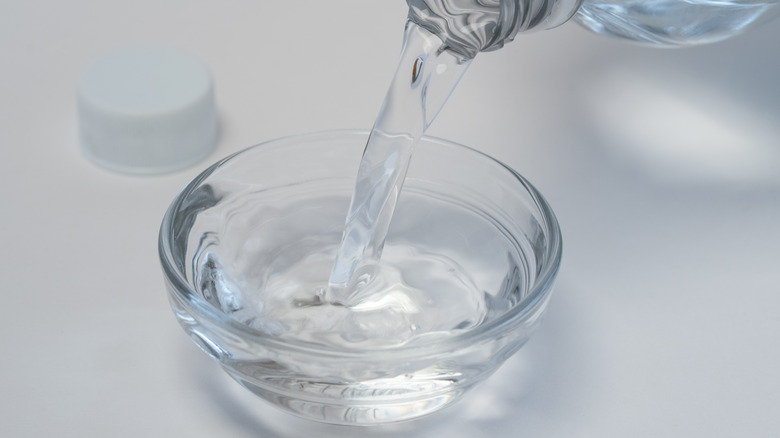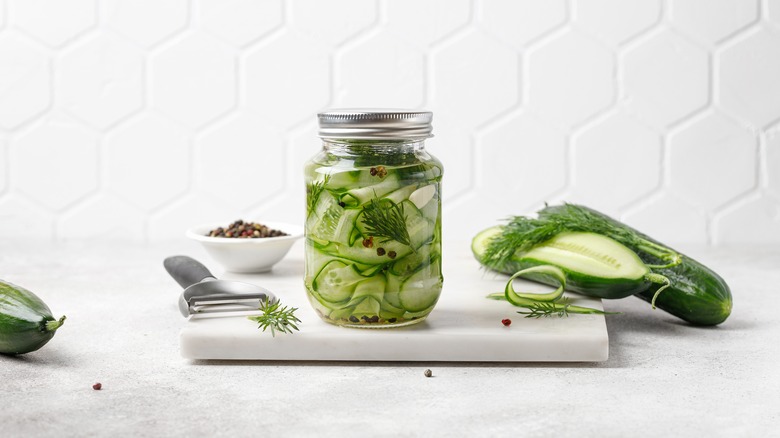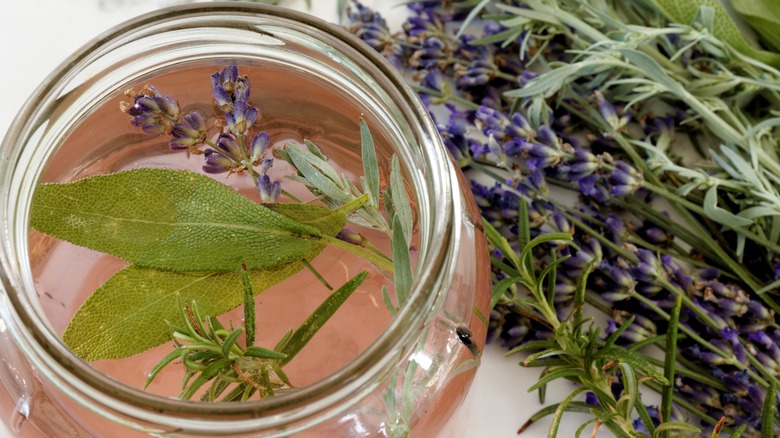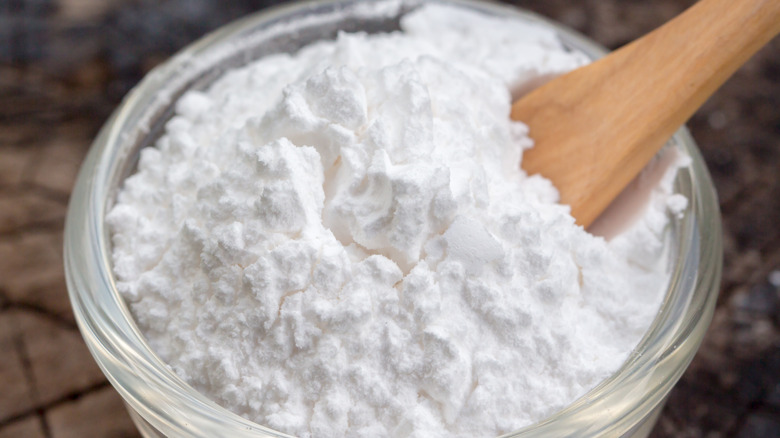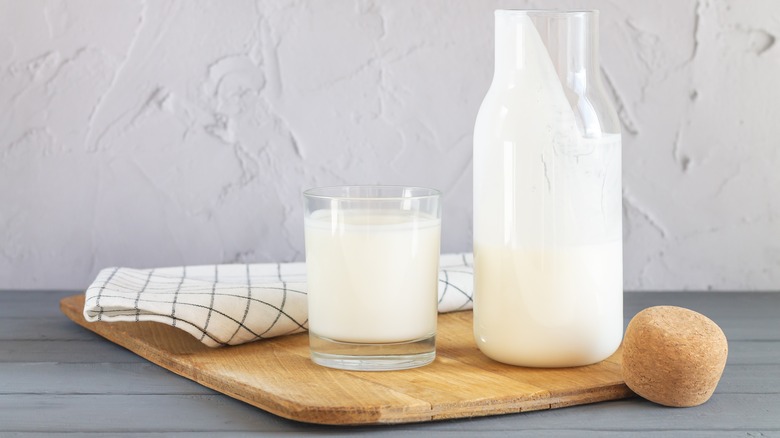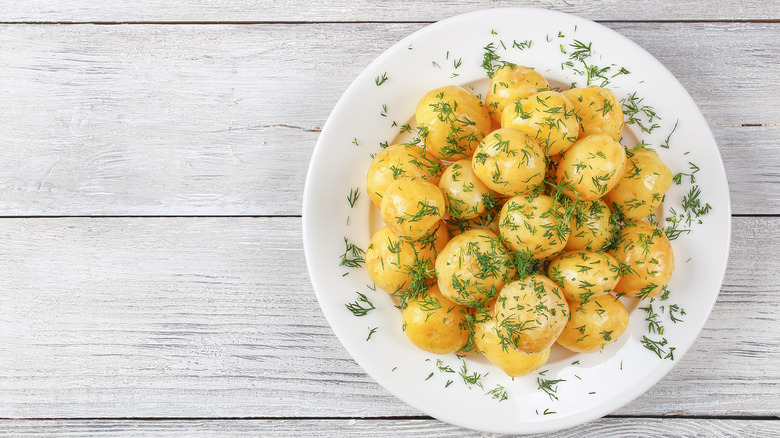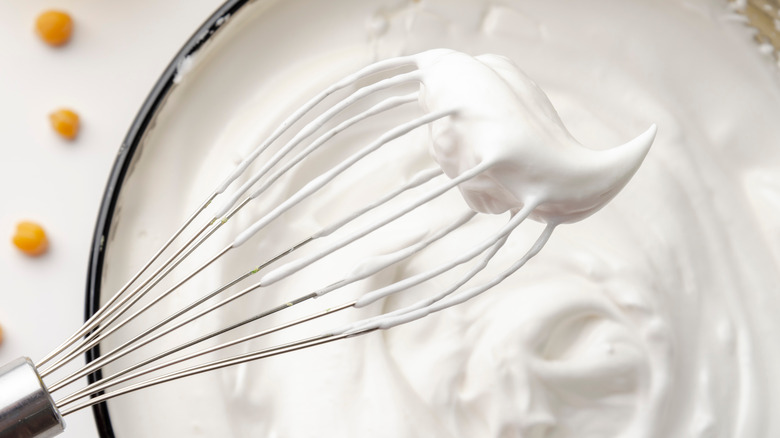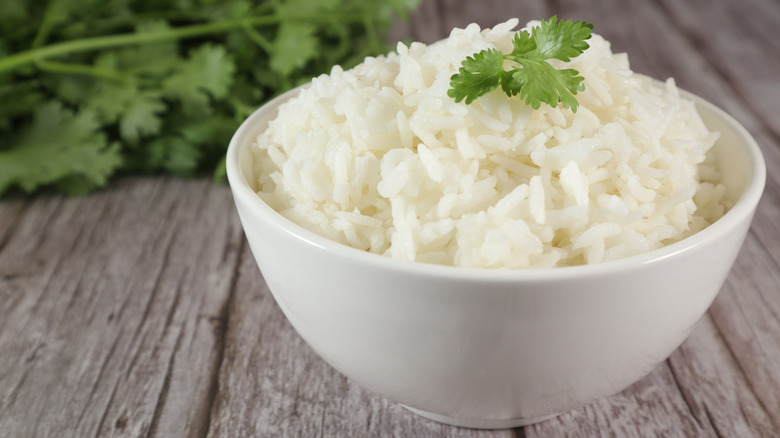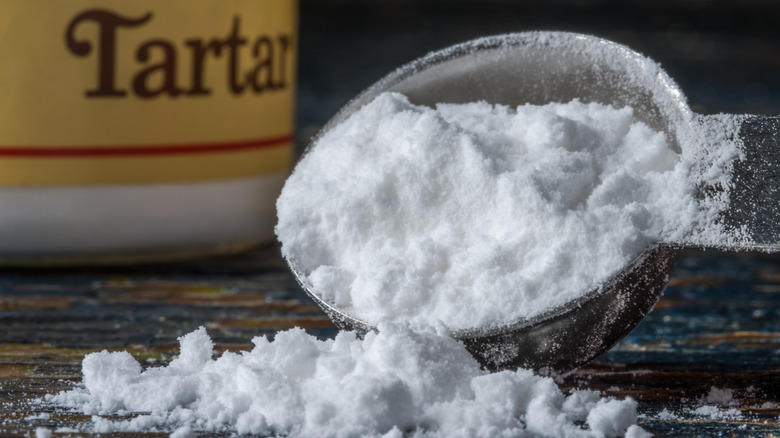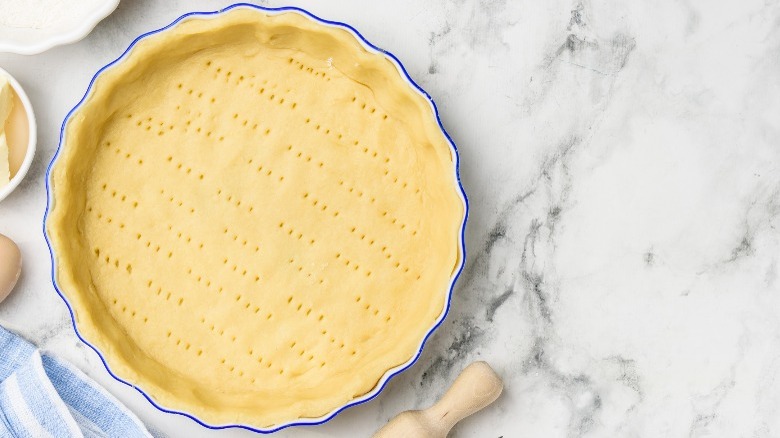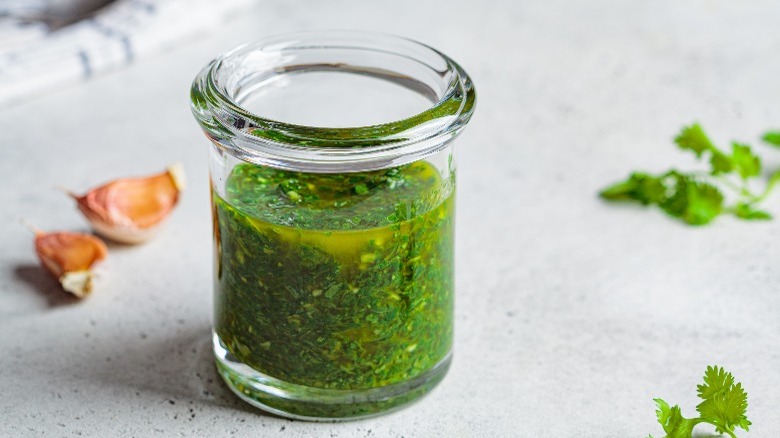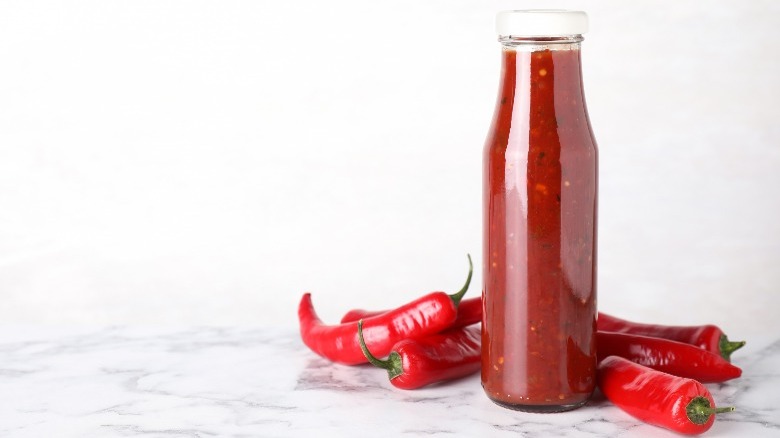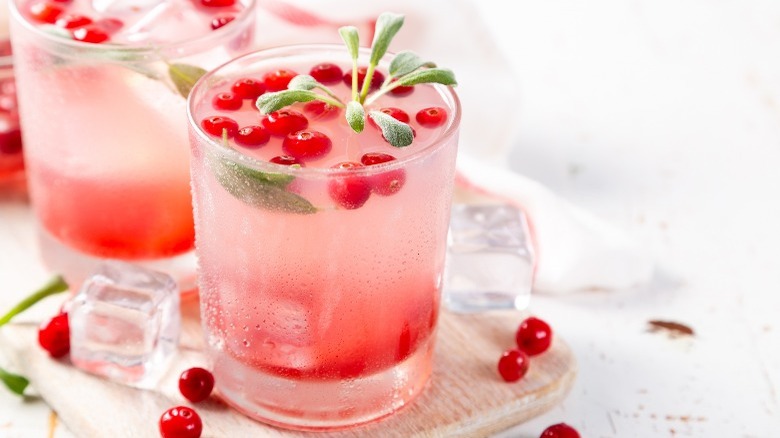13 Ways To Cook With Distilled White Vinegar
Compared to the flashier, fancier members of the vinegar family, distilled white vinegar has an unassuming appearance, an underestimated flavor profile, and a more reasonable price. As a result, its primary role around the house is cleaning, especially as the low-waste, eco-friendly lifestyle gets more popular and DIY natural cleaning solutions become more common. And it does a great job — better than most other kinds of vinegar — but there's a hidden culinary potential waiting to be discovered.
The main difference between distilled white vinegar and other kinds more commonly used in cooking is its source. The colorless, food-grade solution is produced from fermenting diluted and filtered (typically grain-based) alcohol, which promotes the formation of acetic acid (via Harvard T.H. Chan School of Public Health). The process ensures a somewhat neutral yet pronounced flavor, making it perfect for use in the kitchen. So if you have a jug standing idle in your pantry, here are some of the best ways to use white distilled vinegar to ease and elevate your cooking.
1. Get into the pickling game
Do you ever wonder what it would be like to have a fridge filled with various homemade preserves, pickles, and other fermented delicacies but aren't sure how to get there? If the answer is yes, we recommend exploring vinegar pickling. It's a simple, traditional, and accessible preservation method anyone can master.
You can experiment with various kinds of vinegar, but distilled white vinegar is the most common for a few good reasons (via RusticWise). First, it doesn't overpower the flavors of the vegetables too much, thanks to a relatively mild (about 5%) acetic acid content (via Grove Collaborative) comparable to that of white wine or cider vinegar, which leaves you with crispy pickles that retain their taste.
Another reason to go with distilled white vinegar for your daring pickling adventures is its color — or lack thereof — which will ensure that light or bright-colored veggies like cauliflower or peppers will look as good as the day you placed them in the jar. Finally, it's one of the most accessible and budget-friendly kinds of vinegar. You're only a quick trip to a nearby grocery store away from embarking on a fascinating pickling journey filled with crunchy dill pickles, sweet relishes, or even homemade ketchup!
2. Make your own flavored vinegar
If pickling seems too intimidating of a project, there's another way to work with pure distilled white vinegar in cooking that's easy, fun, and versatile. For any recipe that calls for plain white vinegar, substitute a homemade herb or fruit-infused version that will take the meal's flavors to the next level! You could do this with a variety of vinegar. However, the University of Georgia insists that distilled white vinegar pairs really well with herbs, and its clear composition and low price make it the optimal choice for infusing, compared to the murkier apple cider vinegar or the more expensive wine and champagne kinds of vinegar.
Flavored vinegar is safe and easy to make at home (provided that you do a good job sterilizing your glass containers), and there are endless ways to get creative with the flavors. For example, you could infuse it with a combination of cinnamon, orange and rosemary, basil, and other herbs like tarragon, parsley, or dill, as well as various berries and fruit. Bonus: you can give the colorful bottles as a gift or keep them as a kitchen decoration (especially if you're unsatisfied with the flavor profile on your first try).
3. Substitute baking powder
Since its invention in the 19th century (via Smithsonian Magazine), baking powder has been a mainstay in home and industrial kitchens. The reason it's essential in baking is the leavening power it possesses. The dough can rise properly and become fluffy and airy thanks to the powder and the chemical reactions it causes. Its chemical composition is based on two main components: a bicarbonate (baking soda) base and a weak acid, with an added third ingredient (cornstarch) acting as a buffer that prevents a premature chemical reaction between the other two.
Knowing this, we can conclude that baking powder can be replaced with a mix of baking soda and acid — in our case, distilled white vinegar. Mixing the two will cause the same chemical reaction baking powder would: a release of carbon dioxide from bicarbonate upon contact with moisture. There's no more need for an emergency trip to the store for baking powder if the recipe calls for it and you're out! If you combine ¼ tablespoon of baking soda and ½ tablespoon of vinegar per each tablespoon of baking powder required in a recipe, your dough will rise like nobody's business.
4. Make buttermilk in a pinch
Many classic baked goods (think biscuits or cornbread) and breakfast staples like waffles or pancakes often call for buttermilk, an ingredient traditionally made with raw dairy milk and cultures. The reason it's a common ingredient in baking is its acidity, which acts like a leavening agent that reacts with baking soda and results in a product with a fluffy texture and rich flavor.
While homemade buttermilk is commonly made with lemon juice, distilled white vinegar is an excellent substitution when you don't have fresh lemons readily available and would like some fluffy pancakes for breakfast. For each cup of buttermilk required in a recipe, you'll need a tablespoon of vinegar mixed into a cup of milk. If you're using plant-based milk, high-protein varieties like soy, hemp, or oat are best suited for this because they produce more consistent curdling. Let it sit for a few minutes until the milk curdles. Stir carefully, and you're all set!
5. Keep potatoes firm while boiling them
Cooking potatoes into an edible state is a task anyone is up to, but the ability to cook them perfectly could be a challenge. Most of us know how to get fried potatoes crispy and crunchy and mashed potatoes fluffy and creamy. But when it comes to making sure your boiled potatoes hold their shape in a soup or a classic potato salad, things aren't as obvious.
You might already know that the secret to avoiding mushy, boiled potatoes lies in proper storage and choosing the right variety, among other things. Still, a trick you need to try next time you're prepping potatoes is adding a splash of vinegar during the boiling process, which helps them retain their shape. It works because it helps form a thin crust on the surface. Furthermore, adding distilled white vinegar to the soaking or boiling water prevents discoloration, leaving your peeled potatoes white (via The Vinegar Institute).
6. Get stiff peaks with whipped ingredients
There is no point in denying that distilled white vinegar is more often used in cleaning rather than cooking. But there is no need to when you can use its potential to enhance your cooking! A good example would be making vegan meringue (or any other recipe that might call for well-whisked aquafaba).
Similar to egg whites, aquafaba requires specific conditions to be whipped into stiff peaks. The number one factor that makes or breaks its foaming ability is the cleanliness of your bowl and utensils. If there are any traces of fat on the surface (which often happens to plastic bowls), the proteins in aquafaba cannot form bubbles properly, and you risk wasting time and energy trying to make it happen (via Aquafaba.com). That's when distilled white vinegar comes to the rescue: The Vinegar Institute recommends soaking a paper towel with a couple of tablespoons and using that to wipe the mixer's beaters and bowl's surface. Then, wipe them down with a clean paper towel, and prepare for stiff peaks!
7. Ensure your rice is fluffy
If you're a fan of Japanese cuisine, you might be familiar with the common practice of dressing cooked short-grain rice with a mixture of rice vinegar, sugar, and salt (and sometimes mirin or sake), also known as "sushi vinegar." But did you know vinegar could also be used to flavor rice and ensure it cooks perfectly?
Any home cook knows that rice can be tricky to work with, and there is nothing more disappointing than a pot of soggy, clumped, or burned rice. Still, getting that perfectly fluffy bowl should be easy if you know a few basic things. First, consider the starch content of your rice, which is directly related to how sticky or fluffy it will turn out. Luckily, it's easy to approximate starch content just by looking at your grains, as their length correlates with the final level of stickiness (via "Kitchen Smarts: Questions and Answers to Boost Your Cooking IQ"). Therefore, long-grain varieties like Basmati and Jasmine are the most likely to yield the best (least sticky) results.
But if you want to ensure that your rice turns out perfectly fluffy, add a teaspoon of vinegar to the water, along with the rice and salt (via Sweet Peas and Saffron). It will provide additional help in preventing the grains from sticking. And the best part? It doesn't affect the taste!
8. Substitute cream of tartar
Some recipes call for cream of tartar for its acidic quality and stabilizing powers, but unless you bake regularly, that's likely not a pantry staple in your home. And if you've never used it and don't know what it is, cream of tartar (potassium hydrogen tartrate) is an acidic byproduct of wine fermentation that has been around since the 19th century. Don't let the name mislead you: it actually comes in the form of white powder. Fun fact: before modern baking powder was developed, its earliest variations were made with a mix of sodium bicarbonate and cream of tartar, which gave the bakers of the day unprecedented control over the baking process (via American Chemical Society).
In modern kitchens, cream of tartar is most often used to stabilize egg whites (as well as aquafaba), prevent the crystalization of sugar, and leaven dough. However, the ever-helpful distilled white vinegar can become an excellent alternative to the cream of tartar in most recipes, especially in meringues. Unless your dish relies heavily on one particular flavor that sharper-tasting vinegar could affect, cream of tartar and distilled white vinegar are interchangeable, and you can safely use a one-to-one ratio to substitute one for the other.
9. Elevate your pie crust
Pie season is coming up, and home bakers need all the help they can get. Making a holiday dinner is stressful enough, and having to bake this dessert could only add to it, especially if you lack knowledge and experience in pie making. But don't fret: distilled white vinegar is ready to lend a helping hand! While it may seem like an odd addition to the classic flour, butter, and water mix, it is surprisingly effective. Adding a little to the dough will make your homemade pie crust tender and deliciously brown.
One of the ways it improves your dough, according to King Arthur Baking Company, is through oxidation prevention, meaning it won't turn grey while you're working with it or while it's resting, and eventually helps proper browning. Another benefit of using vinegar in your pie dough is the effect this acidic component has on gluten. Martha Stewart mentions a theory claiming that adding liquid to flour promotes gluten development (which is why dough can become hard), and vinegar can prevent it from being overdeveloped. As a result, the dough is easier to work with, and the baked crust is more tender and flaky. But don't forget that vinegar is a relatively strong-flavored acidic ingredient, so a little goes a long way –– you don't want your crust to turn sour! So keep in mind that for every 2½ cups of flour, a tablespoon of vinegar should be enough.
10. Add a kick to your salad dressing
Vinegar is practically synonymous with salad dressings and has been for at least 2000 years, according to The Association for Dressings & Sauces. To this day, it has an incredible power to balance any sauce or dressing, contrasting and enhancing the creamy, fatty, sweet, or spicy flavors with its acidity. Yet, with over 15 common food-grade kinds of vinegar available, white distilled vinegar is often overlooked in cooking, particularly in the sauce and dressing department. Instead, chefs and home cooks typically opt for fancier or milder tasting kinds, like balsamic, apple cider, or champagne vinegar, but they're sometimes pricier or harder to find.
If your goal is to enhance the taste of an existing salad dressing or sauce (as opposed to making a vinaigrette, which relies heavily on the quality and taste of the vinegar), using a splash of distilled white vinegar won't hurt. It will add an immediate burst of flavor to your veggie or pasta salad and balance the competing flavors of a robust herby dressing, like in this chimichurri recipe.
11. Make your own hot sauce
You might have never thought about using vinegar in your sauces, but it's actually quite common. While some salad dressings and vinaigrettes practically scream the ingredient, some thicker, glossier varieties, like ketchup, BBQ sauce, or sriracha, are a bit more subtle. However, distilled vinegar is essential in all of these, lending its acidity to balance and enrich other flavors in these wildly popular condiments. The acidic undertones are the most pronounced in hot sauces, and if you were waiting for a sign to make your own, this is it.
Distilled white vinegar is a popular choice for homemade hot sauce due to its accessibility and sharp flavor profile that compliments the peppers' heat. An easy mango and habanero hot sauce recipe is a great place to start if you're feeling adventurous. Alternatively, try a pickled chile vinegar hot sauce that's relatively neutral and, therefore, more versatile.
12. Make drinking vinegar exciting
While you may have heard of the vinegar-drinking practice to curb the appetite, promote weight loss, or extract other health benefits from the acidic elixir, there is no scientific evidence confirming these claims (via healthline). But guess what you don't need scientific proof for? That's right, how to make a delicious shrub — a much more exciting way to drink vinegar, should you ever feel like it. If you've never heard of a shrub as something other than a leafy growth, it is essentially a cocktail syrup made from vinegar, sugar, and fruit (similar to a switchel).
You can always try it at a local bar or buy it at the store, but making your own couldn't be easier and more affordable. Plus, it's an excellent way to preserve and experiment with seasonal recipes! You can make it from virtually anything: from blueberries and peaches to ginger, tomatoes, and even beets. Just be sure to combine flavors that work together naturally, like rhubarb and strawberries or tomato and basil. Any vinegar with a minimum of 5% acidity will do, which includes distilled white vinegar. Enjoy your shrub with a clear soda or water for a tangy alcohol-free drink, or use it as an ingredient in a cocktail.
13. Keep your eggs intact
If you consume eggs, you might occasionally have trouble cooking them, especially when it comes to something as deceptively straightforward — but surprisingly intricate — as boiling or poaching. Distilled white vinegar can help you make this process more stress-free by affecting the strength of albumin, a protein that egg white is made up of.
If you're hard-boiling older eggs — which are prone to cracking when exposed to high temperatures – 2 teaspoons of vinegar per 1 cup of water should be enough to ensure that even if the shell cracks, the inside stays intact. Similarly, adding a splash of vinegar can help the egg whites come together when poaching. Alternatively, you could switch things up by breaking your eggs straight into vinegar before cooking them. But if all that sounds like too much hassle, the great news is that you can avoid it altogether by switching to plant-based egg alternatives.
